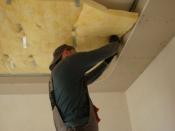Search
Login
The use of penoizol. Penoizol is very convenient, it can be used almost everywhere
In the context of a constant increase in prices for space heating, it is necessary to resort to measures that allow saving to reduce heat loss due to additional warming of the house.
As thermal insulation materials can be used polystyrene, glass wool and penoizol. The most versatile and with a number of advantages insulation is penoizol or modified polystyrene, which can be used for thermal insulation of various structures of a house, industrial and agricultural facilities.
Content
- The composition of penoizol and options for its use video video
- Penoizol: characteristics and operational properties of the material video
- The disadvantages of penoizol and the nuances of its use
- Penoizol universal heat insulator
The composition of penoizol and its use
Externally, penoizol resembles marshmallows or marshmallows. The manufacturing process of penoizol is quite simple, does not require any preliminary preparation and large cash investments.

Carbide resin (one of the varieties) is placed in the bulk container, acid and a foaming substance are added to it. When preparing the solution, one must strictly adhere to the formulation (ratio of components). After mixing, the solution is poured into a device to which compressed air is supplied. This allows you to achieve the formation of lush, airy foam, which will be used as a heater.
In fact, the output is a material similar to polystyrene, only semi-liquid. Foam is supplied from the sleeve of the device and hermetically fills all available gaps, insulating the building structure.

10-15 minutes after exiting the hose, the initial curing of penoizol occurs, and after 4-5 hours the material acquires elasticity. Full hardening occurs in two to three days and penoizol fully begins to fulfill its functions (heat and sound insulation).
Penoizol can be used in three forms:
- liquid form (penoizol filling);
- sheet penoizol (produced in mats and sheets);
- penoizol in the form of crushed crumbs.
Liquid penoizol is considered one of the popular and effective materials used in construction. Its use can significantly reduce the time for insulation work and provide thermal insulation of even the most inaccessible places in the building.
Penoizol sheet is used for thermal insulation of smooth surfaces: floor, roof, walls, ceilings. Often used in the construction of 1-2 storey buildings: country houses, garages, platforms and boxes.

Crushed penoizol is supplied in bags and can fill voids between panel walls, just like liquid penoizol.
Penoizol: characteristics, operational properties and advantages of the material
Consider the main technical characteristics of penoizol, based on which it will be possible to describe the operational properties of the heat-insulating material.
Penoizol Characteristics:
- resistant to temperature fluctuations (can withstand from -50 to +120 degrees);
- thermal conductivity of penoizol 0.035-0.041 (W / m) * C;
- the density of the material is in the range of 8-25 kg / m. cube;
- water absorption per day about 15%;
- humidity by weight of about 10%;
- smoke-generating ability is low (160 gk / m. kV);
- moderately flammable material;
- tensile and compressive strength of 0.05-0.08 kg / cm. kV.
Penoizol has the following properties that affect its operation:
- The low thermal conductivity of penoizol allows it to be used effectively for warming residential buildings and industrial premises (a 10 cm thermal insulation layer is equal in thermal insulation properties to brickwork 1.8 meters thick). The minimum thickness of the thermal insulation should be 5 cm.

- Penoizol is fireproof, which distinguishes it among other polymers. Penoizol not only does not lend itself to burning, it does not melt. Foam is charred and does not allow the fire to spread throughout the material.
- The material has biological and chemical resistance. No microorganisms (mold, fungus) are terrible penoizolu. Mice and rats will not be able to gnaw passages in the insulation, so it is advisable to use it in the attic and basement. Penoizol is not susceptible to chemically aggressive environments.
- Humidity does not spoil the characteristics of the insulating material, and after drying it, unlike mineral wool, continues to retain heat perfectly. The hygroscopicity of the material does not interfere with the natural ventilation of the house.
- Penoizol, more flexible than polystyrene, this feature allows the material to fit snugly and cover all the irregularities of the structures, leaving no voids and gaps.
- The life of the heat insulator reaches 50 years. Such conclusions were reached after a series of experiments and analysis of the use of these polymers in construction. In reality, the time of its use and shelf life are practically unlimited.
- Penoizol is called environmentally friendly, since the level of harmful substances that are released into the atmosphere meets the accepted standards.
Additional advantages of using penoizol in construction can be considered:
- soundproofing of the room;
- the lightness of penoizol does not create an unnecessary load on structures and structures;
- house insulation with penoizol can be carried out at any temperature (even in the winter months);

- the cost of warming the house with penoizol is lower than the costs incurred for thermal insulation of the room with other materials;
- penoizol can be poured into a cavity (capacity, hole) of any volume and any shape;
- efficiency of work.
The disadvantages of penoizol and the nuances of its use
The disadvantages of penoizol include:
- The material does not increase its volume (although many believe that this is so), but rather, over time, it shrinks by 0.1-5%. It depends on the correctness of the creation of the solution (liquid penoizol) and the environment where it is used.
- If low-quality and cheap resins were used to create penoizol, then after pouring the heat-insulating material can emit an unpleasant odor. The same may result from the use of old equipment for spraying foam or low-quality components of the solution (foaming agent and acid).

- The high vapor permeability of penoizol can cause moisture to accumulate in the insulating material, and when the heat insulator is very wet, urea foams start to release urea and formaldehyde. Therefore, some masters consider it necessary to waterproof the penoizol layer.
- In its strength, penoizol is inferior to polystyrene and cracks in the insulation can occur during shrinkage.
- With vertical insulation with penoizol, pouring must be carried out in several stages. This is due to the fact that the solidification of the material does not occur instantly and penoizol is in a fluid state for some time.
- To perform the work, modern equipment and qualified specialists are required, since poor-quality filling will be difficult to remove.
Penoizol universal heat insulator
application of penoizol in warming houses
The main scope of the use of penoizol is the insulation of building structures. The universality of the material lies in the fact that it can be used to warm any elements of the structure at any stage of construction.

To warm the house, any form of applying penoizol can be used: in crushed or sheet form, as well as by pouring technology.
Here is a list of the main objects of insulation with penoizol:
- insulation of residential buildings, including frame, brick, country cottages, garden buildings;

- warming a wooden house with penoizol is quite effective, since the insulation regulates the moisture exchange in the room in much the same way as wood;
- wall insulation with penoizol from the inside and outside of the house;
- insulation of the facade and inter-wall space;
- thermal insulation of three-layer brick and combined walls;
- insulation of the roof (flat and sloping), attic, attic;
- filling the cavities of walls and voids of double ceilings with insulation;
- insulation of the foundation and floors, including floors on the logs;

- thermal insulation of interfloor ceilings, including wooden beam;
- insulation of false ceilings;
- thermal insulation of building structures (doors, frames, windows, panels with a metal or wooden frame);
- warming of loggias, balconies;
- insulation of cold bridges;
- filling trench cavities;
- floor insulation of buildings under construction.
As you can see, the list is quite wide, which indicates the demand and popularity of warming houses with penoizol. Reviews of people who have experienced the properties of penoizol in their homes are mostly positive, and often depend on the professionalism of the workers who performed the insulation.
use of penoizol in industry and agriculture
In addition to warming residential buildings, penoizol is used for thermal insulation of industrial and agricultural facilities.
This material provides insulation of the following industrial structures:
- industrial premises (warehouses, hangars, boxes and hanging platforms);

- warming of individual structural elements of the structure (trusses, beams, roofs, columns);
- warming of collapsible structures;
- thermal insulation of industrial, domestic refrigeration units;
- soundproofing of vehicles;
- thermal insulation of equipment, drying chambers, heat exchangers, tanks;
- in the arrangement of sound-absorbing ceilings that can reduce the level of industrial noise;
- thermal insulation of pipes, vegetable stores, wagons, tanks, ducts and cooling systems;

- as a thermal insulation coating that protects construction, mining pits and trenches from seasonal freezing;
- thermal insulation of boilers, boilers, tanks.
In agriculture, penoizol is effectively used as a shelter to preserve silage and silage. Some use penoizol pouring technology to protect the soil and bulk materials from freezing. In beekeeping, hives for wintering are insulated with penoizol sheets.

And of course, with the help of penoizol thermal insulation of cribs and other outbuildings is carried out.
experience using penoizol abroad
In different countries of the world, penoizol has a different name and distinctive features of the application. Due to its manufacturability, it occupies a worthy place among other high-quality heat-insulating materials.
In developed countries, it is precisely pouring souffle-shaped penoizol that is practiced. In the Czech Republic, when building a multi-storey building, reinforced concrete slabs are often used, the grid of which is covered with mofoterm (the name of penoizol in the Czech Republic). After installing the slab and shrink the heat insulator, a cement screed is applied to the foam, which prevents the destruction of the insulation.
In Germany, the use of animaterms (the local name of penoizol) for warming wooden houses is popular. This is due to the fire safety of the material.

In Holland, penoizol has been distributed since 1974 and is used to warm hollow brick walls of buildings. Filling takes place by pouring or finished plates.
Canadians fill with foamisol (insulant foam) spatial reinforced concrete elements of curtain panels and hollow brick walls to insulate and soundproof them. A similar practice is observed in Poland, France and the Baltic countries.

In the USA, penoizol is widely used in industry, namely for the thermal insulation of wagons and containers designed to store liquid gases. In addition, special caps for equipment are created from penoizol, which absorb production noise.
In recent years, the trend towards the use of penoizol abroad and in Russia has been growing. Such dynamics is due to the appearance of modern equipment, which allows to apply foam insulation in a high-quality manner, as well as the versatility and high performance characteristics of the material itself.





